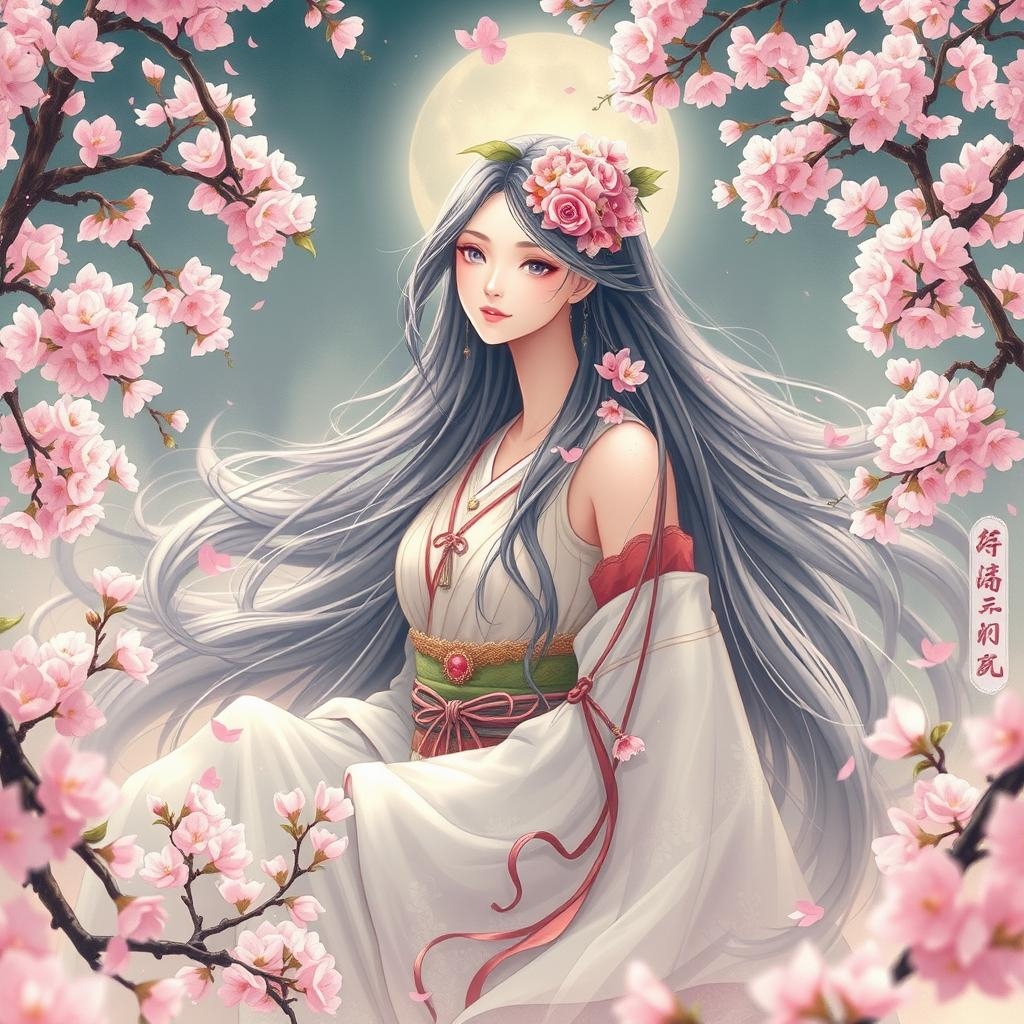木花咲耶姫(このはなさくやひめ)は、日本の神話に登場する女神で、特に『古事記』や『日本書紀』に記されています。彼女は主に桜の花を象徴する神として知られていますが、火と関係する伝説もあります。
### 神格と象徴
1. **自然の象徴**:
– 木花咲耶姫は名前に「咲く」という言葉が含まれている通り、花、特に桜の花の神として広く認識されています。春を象徴する女神として、日本の自然美を体現しています。
2. **家族**:
– 縁結びの神とされる瓊々杵尊(にぎのみこと)の妃(妻)です。
– 彼らの間には三柱の子供がおり、その中には有名な火の神である火遠理命(ほおりのみこと、別名:彦火出見尊(ひこほでみのみこと)が含まれています。この火の神の伝承は、後に海幸山幸の物語に繋がります。
### 神話のエピソード
1. **結婚と試練**:
– 瓊々杵尊と結婚する際に、彼が彼女の貞操を疑ったため、木花咲耶姫は火の中で無事に子供たちを出産したという逸話があります。これは彼女が信頼性と誠実さを示すための試練とされており、火の試練を象徴しています。このストーリーは彼女が火の苦難を乗り越える力を持つと同時に、清浄さを表すものとも解釈されています。
2. **神社の祭神**:
– 彼女を祀る代表的な神社には、富士山本宮浅間大社やその他の浅間神社があり、特に富士山との関連で信仰されています。
### 現代の文化と影響
木花咲耶姫は、日本文化において非常に重要な存在で、特に桜の季節には広く祭られます。彼女の神話や象徴は日本の文学や芸術、そして多くの地域の祭りや伝統行事の中で見ることができます。また、彼女の象徴は新年度の始まりや新しい生命の誕生など、生命の再生と活力を祝うものとして大切にされています。
このように、木花咲耶姫は日本の文化や自然に深く根ざした存在であり、古代から現代に至るまで、多くの人々の心に響き続けています。
木花咲耶姫(このはなさくやひめ)と富士山との関係は、日本の神話や伝説において非常に深いものがあります。この神様は特に富士山の象徴として崇拝されており、彼女にまつわる神話や信仰が富士山と結びついています。
### 富士山との関わり
1. **信仰の中心地**:
– 木花咲耶姫は、富士山本宮浅間大社で祭られています。この神社は富士山の山頂にある浅間神社の総本社であり、彼女を祀る主要な場所とされています。この神社では、彼女が農作物の豊穣や安産の神としても崇められています。
2. **桜と富士山**:
– 富士山は美しい景観で知られ、春には桜とのコラボレーションが見られます。木花咲耶姫は桜の女神であるため、彼女の存在が富士山の美しさや自然の豊かさを象徴しています。観光地としても、桜と富士山の風景は、日本の春の風物詩として多くの人々に親しまれています。
3. **神話的な結びつき**:
– 富士山は木花咲耶姫の父である大山祇神(おやまつみのかみ)と関連付けられることがあります。大山祇神は山の神であり、自然の恵みをもたらす存在とされています。このように、木花咲耶姫の神聖性と富士山の自然の豊かさが一体となり、相互に補完し合っているのです。
4. **災害と防災**:
– また、富士山は活火山であり、歴史上多くの噴火を起こしています。木花咲耶姫が火との関係を持つ神であるため、彼女は火災や自然災害からの防護の神としても信仰されています。富士山周辺の住民は、彼女が護る存在であると考え、彼女に祈りを捧げることが重要視されています。
### 文化的な影響
木花咲耶姫と富士山の結びつきは、日本文化において根強い影響を与えており、特にアートや文学、祭りなどでその姿を見ることができます。彼女の象徴が富士山と結びつくことで、自然崇拝や生命の再生といったテーマが強調され、日本人の心に深く根ざしています。
このように、木花咲耶姫は富士山と共に、日本の自然と文化の中で重要な役割を果たしているのです。
■英語に翻訳いたしました。

—
Konohanasakuya-hime is a goddess featured in Japanese mythology, especially noted in texts such as the Kojiki and Nihon Shoki. She is primarily known as a deity symbolizing cherry blossoms, but she is also associated with fire in certain legends.
### Divine Nature and Symbolism
1. **Symbol of Nature**:
– As suggested by her name, which includes “bloom,” Konohanasakuya-hime is widely recognized as the goddess of flowers, particularly cherry blossoms. She embodies the beauty of Japan’s natural scenery, especially the spring season.
2. **Family**:
– She is married to Ninigi-no-Mikoto, a deity known for bringing prosperity and is also associated with marriage blessings.
– They have three children, including the famous fire deity Hoori-no-Mikoto, also known under another name, Hikohohodemi-no-Mikoto. This fire deity is central to the tale known as the “Umisachi-Yamasachi” (The Luck of the Sea and the Luck of the Mountain).
### Mythical Episodes
1. **Marriage and Trial**:
– Upon marrying Ninigi-no-Mikoto, her fidelity was questioned. To prove her innocence and purity, Konohanasakuya-hime gave birth successfully inside a burning hut. This legend highlights her attributes of reliability and integrity, suggesting her ability to withstand trials by fire. The story is interpreted as showing her purity and transcendence of challenges.
2. **Worship at Shrines**:
– She is venerated at numerous shrines, most notably the Fujisan Hongu Sengen Taisha and other Asama Shrines, reflecting her strong association with Mount Fuji.
### Modern Cultural Influence
Konohanasakuya-hime holds significant importance in Japanese culture, especially celebrated during the cherry blossom season. Her myths and symbols are deeply intertwined in Japanese literature, art, and many festivals and traditional events. Furthermore, she symbolizes the celebration of new beginnings and the renewal of life, marking the start of a new year and the birth of new life.
Thus, Konohanasakuya-hime continues to resonate deeply in the hearts of many people, from ancient times to the present, through her deep connection with Japanese culture and nature.
★★★★★★★
—
Konohanasakuya-hime has a profound relationship with Mount Fuji in Japanese mythology and legend. She is particularly revered as a symbol of Mount Fuji, and many myths and beliefs surrounding her are intertwined with the mountain.
### Connection to Mount Fuji
1. **Center of Worship**:
– Konohanasakuya-hime is enshrined at the Fujisan Hongu Sengen Taisha, the head shrine of the Asama shrines located at the foot of Mount Fuji. This shrine serves as a key place of worship for her, where she is revered as the goddess of agricultural abundance and safe childbirth.
2. **Cherry Blossoms and Mount Fuji**:
– Mount Fuji is famous for its picturesque scenery, especially in spring when cherry blossoms bloom. As the goddess of cherry blossoms, Konohanasakuya-hime symbolizes the beauty of Mount Fuji and the richness of nature. The landscapes featuring both cherry blossoms and Mount Fuji are cherished by many and are celebrated as a quintessential part of Japan’s spring.
3. **Mythical Connections**:
– Mount Fuji is sometimes associated with Oyamatsumi-no-Kami, the father of Konohanasakuya-hime. Oyamatsumi-no-Kami is the god of mountains and is believed to bring the blessings of nature. This connection reinforces the sacredness of Konohanasakuya-hime and the bountiful nature of Mount Fuji, as they complement one another.
4. **Disaster and Protection**:
– Additionally, Mount Fuji is an active volcano with a history of eruptions. Given that Konohanasakuya-hime is related to fire, she is also worshipped as a protector against fires and natural disasters. Residents near Mount Fuji consider her a guardian and place great importance on praying to her for safety from calamities.
### Cultural Influence
The bond between Konohanasakuya-hime and Mount Fuji has had a lasting impact on Japanese culture, visible in art, literature, and festivals. Her symbolism, linked with Mount Fuji, emphasizes themes of nature worship and the rebirth of life, ingraining themselves deeply in the hearts of the Japanese people.
In this way, Konohanasakuya-hime plays a significant role alongside Mount Fuji, contributing to the richness of Japan’s natural and cultural landscape.
【絵本】ガンと闘う10歳の僕におきた奇跡
の書籍版はこちらから
☆☆☆☆☆☆☆☆☆☆☆☆☆☆☆☆☆☆☆☆☆☆☆☆
生き抜く力【ガンと闘う10歳の僕に起きた奇跡】|ほっし校長|note
жжжжжжжжжжжжжжжжжжжжжжжжжжжжжжжжжжжж
